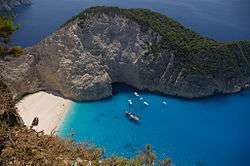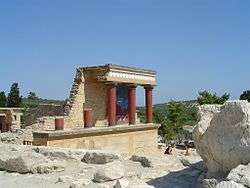Tourism in Greece
| Economy of Greece |
|---|
 |
| Overview |
| History |
| Related |
|
Tourism in Greece has been a key element of the economic activity in the country, and is one of the country's most important sectors. Greece has been a major tourist destination and attraction in Europe since antiquity, for its rich culture and history, which is reflected in large part by its 18 UNESCO World Heritage Sites, among the most in Europe and the world[1] as well as for its long coastline, many islands, and beaches.[2]
Greece attracted 26.5 million visitors in 2015, 30.1 million visitors in 2017 and over 33 million visitors are expected in 2018, [4] [5] [6] [7][8] making Greece one of the most visited countries in Europe and the world, and contributing 18% to the nation's Gross Domestic Product.[9] Its capital city Athens, as well as Santorini, Mykonos, Rhodes, Corfu, Crete and Chalkidice are some of the country's major tourist destinations.
In recent years, Greece has also promoted religious tourism and pilgrimages to regions with a significant historical religious presence, such as the monasteries in Meteora and Mount Athos, in cooperation with other countries.[10]
Land and Climate
Greece has a Mediterranean climate along its coasts and islands. Once inland, many areas and cities experience a continental climate.[11]
Summers are usually hot and dry, while winters are generally mild and wet. Northern Greece can experience cold winters, while Southern Greece and the islands experience considerably milder winters.[12]
History
Tourism in Greece traces its roots to ancient times. Cultural exchange took place between the Greek colonies of Magna Graeca and the young Roman Republic before Rome's rise to dominance of the Western Mediterranean. When Greece was annexed by the Roman Empire centuries later, the cultural exchange that started between the two civilization triggered as a result a large number of Romans visiting the famous centers of Greek philosophy and science, such as Athens, Corinth and Thebes, partly because Greece had become a province of the Roman Empire and Greeks were granted Roman citizenship.
Tourism in modern-day Greece started to flourish in the 1960s and 1970s, in what became known as mass tourism.[13] During that time, large-scale construction projects for hotels and other such facilities were undertaken and the country saw an increase in international tourists over the years.[13] International events such as the 2004 Summer Olympic Games and the Eurovision Song Contest 2006, both held in Athens, greatly helped to boost tourism in the country, while large-scale nationally funded cultural infrastructure such as the New Acropolis Museum also contributed to the flow of tourists in the country. Thessaloniki was the European Youth capital in 2014.
Visitors
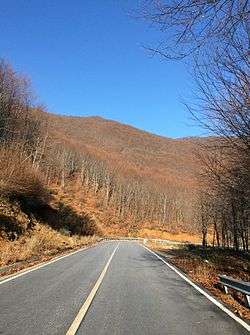

In 2009, the country welcomed over 19.3 million tourists,[14] a major increase from the 17.7 million tourists the country welcomed in 2008.[15] The vast majority of tourists in the country are from within the European Union (12.7 million), followed by those from the Americas (0.56 million), Asia (0.52 million), Oceania (0.1 million) and Africa (0.06 million).[16] In the year 2007, more British people visited the country than any other nationality, numbering 2.61 million in total, making up 15% of the country's tourists for that year alone. Additionally, 2.3 million Germans, 1.8 million Albanians and 1.1 million Bulgarians visited the country that year.[16] In 2007, 92.8% of the total number of tourists in Greece were from countries in Europe.[16]
The most-visited region of Greece is that of Central Macedonia in northern Greece, near some of the most popular attractions in the country such as Halkidiki, Mount Olympus, Pella, the birthplace of Alexander the Great, and Greece's second-largest city, Thessaloniki.[15] In 2009, Central Macedonia welcomed 3.6 million tourists, or 18% of the total number of tourists who visited Greece that year,[15] followed by Attica (2.6 million) and the Peloponnese (1.8 million).[14] Northern Greece is the country's most-visited region, with 6.5 million tourists, while Central Greece comes second with 6.3 million.[14]
According to a survey conducted in China in 2015, Greece was voted as the Chinese people's number one choice as a tourist destination.[17] In November 2016, Austria, like China, announced that Greece was the favourite tourist destination for its citizens.[18] In line with these observations, Greece's former Minister of Tourism Aris Spiliotopoulos announced the opening of a Greek National Tourism Organization office in Shanghai by the end of 2010, and GNTO currently operates two tourism offices in China, one in Shanghai and one in Beijing.[19] It is estimated that throughout 2013 Greece welcomed over 17.93 million tourists, an increase of ![]()
Arrivals by country
The neighboring Republic of Macedonia had the highest number of tourists visiting Greece in 2015. The top 10 countries were:[24]
| Rank | Country | Number |
|---|---|---|
| 1 | 3,023,059 | |
| 2 | 2,810,350 | |
| 3 | 2,397,169 | |
| 4 | 1,900,642 | |
| 5 | 1,522,100 | |
| 6 | 1,355,327 | |
| 7 | 1,153,046 | |
| 8 | 754,402 | |
| 9 | 750,250 | |
| 10 | 727,831 |
Economic impact
At the same time, tourism consumption increased considerably since the turn of the millennium, from US$17.7 bn. in 2000 to US$29.6 bn. in 2004. The numbers of jobs directly or indirectly related to the tourism sector were 659,719 and represented 16.5% of the country's total employment for that year.
Infrastructure
As a developed country highly dependent on tourism, Greece offers a wide variety of tourist facilities.[25] Tourism infrastructure in Greece has been greatly improved since the 2004 Athens Olympic Games and continues to expand with a number of important projects particularly in areas of less mass-tourism.[26]
Beach resorts

Some popular beach resorts include Crete, Rhodes, Kos, Corfu, Kefalonia, Zante and Skiathos attracting millions of foreign tourists every year.[27]
Hotels and conference facilities
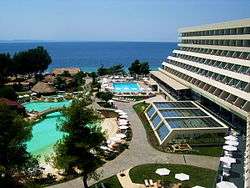
Conference tourism, targeted at academic, business, or cultural markets, is a cornerstone of the Greek national tourism policy. As a result, the Greek government, with strong support from local authorities, has been offering lucrative cash grants, leasing and employment subsidies and tax allowances to establish new conference facilities and expand existing ones. In a recent report in Meeting and Incentive Travel, Greece was ranked eighth in the world in overnight stays for conferences. Figures from the Tourism Satellite Accounting Research, conducted by WTTC (World Travel & Tourism Council) project a worldwide increase in revenues in business travel to Greece from US $1.51 bn. in 2001 to US $2.69 bn. in 2011. In 1998, the figure stood at US $1.18 bn.
According to the Hellenic Chamber of Hotels in 2016, the number of hotels in Greece was by classification (bedplaces):[28]
| Star rating | Number | Beds |
|---|---|---|
| 5 star | 444 | 137,210 |
| 4 star | 1,412 | 203,203 |
| 3 star | 2,472 | 185,560 |
| 2 star | 3,990 | 210,365 |
| 1 star | 1,412 | 52,215 |
| Total | 9,730 | 788,553 |
Marinas
Greece has 51 marinas and 14,661 mooring places that provide such services as berths, fuel, water and electricity, telephony, and repairs.
Some of the most developed and busiest marinas in Greece are just a few kilometres from the centre of Athens. The marinas of Alimos and Flisvos, on the south coast of Athens, have an aggregated capacity of more than 1,800 vessels.
Spas and thermal springs
Greece has 752 thermosprings. Many have been classified as therapeutic by the National Institute for Geographical and Mineral Research. Several of them were known and exploited already since antiquity. Thermal or curative tourism was, after all, one of the earliest forms of tourism in the ancient world. In 1983 was founded the Hellenic Association of Municipalities with Thermal Springs Some of these ancient "spa resorts" were situated in Aidipsos, known from the time of Aristotle,[29] Loutraki, mentioned by Xenophon,[30] Traianoupoli , founded by the emperor Trajan in the 2nd century A.D., whereas some others are attested in the Byzantine period, such as the Thermal baths of Langadas . In the late 19th and the beginning of the 20th century these hot springs were surrounded by cosmopolitan facilities, namely hotels and restaurants, whereas several prominent members of the society of both the Modern Greek State and the Ottoman State (for regions still incorporated in it) invested in touristic infrastructure and private estates.[31] Thermal tourism became particularly widespread in the 1960s and 1970s, whereas in the 1980s it was widely supported by a social tourism program, which subsidized large part of the expenses for the elderly users of the facilities. Nowadays, however, there is an urgent need to refurbish, restore and elevate these spas to modern standards and create an international clientele. Visitors, however, can already find high-standard touristic facilities in Pozar , in Aidipsos and in Kamena Vourla , in Loutraki close to Corinth as well as at Kaiafas, on the western shores of the Peloponnese . A detailed List of spa towns in Greece can give an insight in the inexorable richness of thermal springs of the country.
Cultural attractions
Museums
.jpg)
Several kinds of museums are located in the Hellenic Republic. Generally speaking, every major city and town in Greece has its own Archaeological Museum, which houses findings from the nearby area. However, most of them can be found in the big cities like Athens, where the famous New Acropolis Museum and the National Archaeological Museum are located. Furthermore, there is a vast number of galleries like the National Gallery (Athens). There are many museums in Thessaloniki too, like the Byzantine Museum. Overall, there are approximately 150 museums all over the country which are easily accessible by tourists.
Archaeological sites and cities


.jpg)
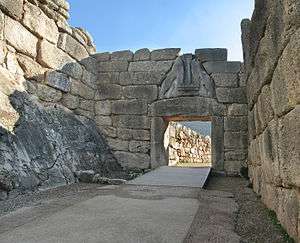
- Acropolis of Rhodes: The Acropolis of Rhodes is an acropolis dating from the Classical Greek period (5th–3rd century BC).
- Acropolis of Lindos: A natural citadel which was fortified successively by the Greeks, the Romans, the Byzantines, the Knights of St John and the Ottomans.
- Ancient Thera: An antique city on a ridge of the steep, 360 m high Messavouno mountain on the Greek island of Santorini.
- Abdera, Thrace: A city-state on the coast of Thrace 17 km east-northeast of the mouth of the Nestos, and almost opposite Thasos.
- Akrotiri (Santorini): A Minoan Bronze Age settlement on the volcanic Greek island of Santorini (Thera).
- Ambracia: Ruins of the ancient capital of Pyrrhus of Epirus in modern Arta in Epirus.
- Amphipolis: An ancient city in the region of Macedonia once inhabited by the Edoni people.
- Argos: Several ancient ruins, including the Heraion.
- Asclepeion of Kos: The ruins of one of the greatest healing temples of the Ancient World and the place where Hippocrates, the father of modern medicine was trained.
- Athens: The Greek capital has many archaeological sites, the most famous being the Acropolis, the Temple of Olympian Zeus, the Ancient Athenian cemetery of Kerameikos, the Philopappou Hill, the Tower of the Winds, Plato's Academy and the Ancient Agora.
- Bassae: An archaeological site in the northeastern part of Messenia, Greece.
- Chalcis: on Euboea.
- Ancient Corinth: Ancient ruins near the modern town include the Temple of Isthmia and the Temple of Apollo.
- Delos: Uninhabited island famous for its numerous archaeological sites, including the Stoivadeion, the Temple of the Delians, the Terrace of the Lions and the House of the Dolphins.
- Delphi: Town in western Greece, with a distinguished ancient theatre, the site of the Oracle.
- Didymoteicho: A historical town of Thrace built near the Greek-Turkish border which has many Ancient Greek, Byzantine and Ottoman landmarks, including the ruins of the ancient city of Plotinopolis, the Byzantine fortifications built around the town, the Bayezid Mosque built in 1420 and the Silent Baths, the oldest hamam in Europe.
- Dion, Pieria: The sacred place of the Ancient Macedonians. Dion is the site of a large temple dedicated to Zeus, as well as a series of temples to Demeter and to Isis.
- Dodona: The shrine of Dodona in Epirus was regarded as the oldest Hellenic oracle, possibly dating to the second millennium BC according to Herodotus.
- Eleusis: From as early as 1700 BC up to the 4th century AD, Eleusis was the site of the Eleusinian Mysteries, or the Mysteries of Demeter and Kore.
- Elaea (Epirus): An ancient town near the mouth of the Acheron river of Epirus.
- Epidaurus: The ancient theatre, now restored.
- Gitanae: Ruins of ancient Gitanae in Epirus.
- Kameiros: An ancient city on the island of Rhodes, in the Dodecanese, Greece.
- Knossos: Archaeological site on Crete famous for its ruined Minoan palace, with bull motifs.
- Leibethra: An ancient city close to Olympus where Orpheus was buried by the Muses.
- Lycian Tomb, Kastellorizo: A rock cut tomb built by the ancient Anatolian civilization of the Lycians, located at Kastellorizo, the easternmost island of Greece.
- Lycosura: A city of Arcadia said by Pausanias to be the oldest city in the world.
- Marathon tumuli: Burying mounds in Marathon, Attica that house the ashes of the Athenian and Plataean hoplites that were killed in the homonymous battle. The Archaeological Museum of Marathon, built near the tumuli preserves findings from the area and from the battle of Marathon.
- Meteora: The monasteries, which are World Heritage Sites.
- Mycenae: In the second millennium BC, Mycenae was one of the major centres of Greek civilization, a military stronghold which dominated much of southern Greece and parts of southwest Anatolia. The period of Greek history from about 1600 BC to about 1100 BC is called Mycenaean in reference to Mycenae.
- Messene: Most of the area of Ancient Messene contains the ruins of the large classical city-state of Messene refounded by Epaminondas in 369 BC.
- Necromanteion: Nekromanteion was an ancient Greek temple of necromancy devoted to Hades and Persephone.
- Nemea: Here in Greek mythology Heracles overcame the Nemean Lion of the Lady Hera, and here during Antiquity the Nemean Games were played.
- Nicopolis: or Actia Nicopolis was an ancient city of Epirus, founded 31 BC by Octavian in memory of his victory over Antony and Cleopatra at Actium the previous year.
- Olympia: Many ancient ruins, including the Temple of Zeus, the Temple of Hera, the Palaestra and the Leonidaion.
- Olynthus: An ancient city of Chalcidice.
- Palace of Nestor: Palace of Nestor is the primary structure within a larger Late Helladic era settlement, likely once surrounded by a fortified wall
- Pella: The capital of Ancient Macedonia and birthplace of Alexander the Great and Philip II of Macedon.
- Phaistos: a Bronze Age archaeological site at Faistos, a municipality in south central Crete.
- Philippi: Established by the king of Macedon, Philip II, on the site of the Thasian colony of Krinides or Crenides.
- Sounion: The Temple of Poseidon.
- Samothrace temple complex: is one of the principal Pan-Hellenic religious sanctuaries, located on the island of Samothrace.
- Syros: Neoclassical city of Hermoupolis; two civilizations and two religions living harmonically and peacefully together; only 2.5 hours by ferry from Piraeus; a 12-month a year destination; beaches, classical theatre, casino, general hospital and many places to see.
- Stagira: Ruins of the ancient city known as the birthplace of Aristotle.
- Sparta: Near the modern town are ancient ruins, the most important being the tomb of Leonidas.
- Tiryns: A Mycenaean archaeological site in Argolis in the Peloponnese.
- Tegea: A settlement in ancient Greece. Ancient Tegea was an important religious center of ancient Greece, containing the Temple of Athena Alea.
- Thebes: Ancient city that once rivalled Athens, and featured in Greek myth.
- Thermopylae: Primarily known for the battle that took place there in 480 BC, in which an outnumbered Greek force probably of seven thousand (including the famous 300 Spartans) held off a substantially larger force of Persians estimated in the range 70,000-300,000 under Xerxes.
- Thessaloniki: Nicknamed the "Co-capital", city with many historic buildings, some World Heritage Sites, including the Arch and Rotunda of Galerius, the Church of Panagia Chalkeon and the White Tower.
- Vergina: The Macedonian Royal Tombs and the ruins of the ancient Macedonian capital in the region of Macedonia, Greece. It is a World Heritage Site.
- Zakros: A Bronze Age archaeological site of Crete, built on the eastern coast of the island.
Ecotourism and skiing
Greece has become in recent years a destination for ecotourism (especially hiking, canoeing, caving and climbing).[32] The main destinations for skiing in Greece are Arachova, Kalavryta, Karpenisi and Metsovo.[33]
Promoting Greek tourism
.jpg)
The government intends to promote winter tourism in Greece, which could potentially increase international arrivals even further.
Tourism in Greece is run by the Greek National Tourism Organisation (GNTO) who used Helena Paparizou, a famous Greek singer who won Eurovision Song Contest in 2005 as an ambassador. Singer Sakis Rouvas,[34] who represented Greece in the 2009 Eurovision song contest, is currently the ambassador for Greek Tourism.
The advertisements displayed in the GNTO's web"site still focus on the triptych of sea, sun and sand. However, the tourism campaign is undergoing a significant change as city-breaks and conference tourism are promoted, along with cultural and wellness tourism. The impact of the new campaign will hopefully result in increased tourist revenues. The name of commercials is "You in Greece".
Gallery
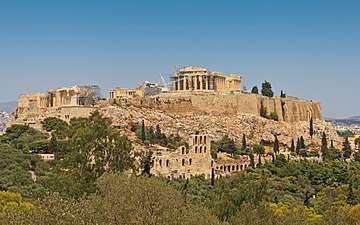 View of Acropolis of Athens from the south.
View of Acropolis of Athens from the south.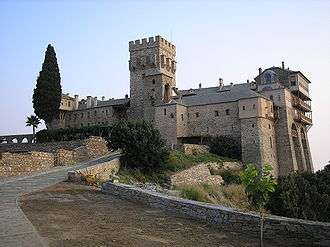 Stavronikita monastery in Mount Athos, Chalkidice
Stavronikita monastery in Mount Athos, Chalkidice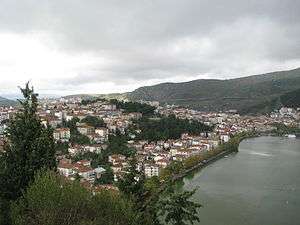 The city of Kastoria, on the shores of Lake of Kastoria
The city of Kastoria, on the shores of Lake of Kastoria
.jpg)
 The Lion of Amphipolis, near the Kasta Tomb
The Lion of Amphipolis, near the Kasta Tomb
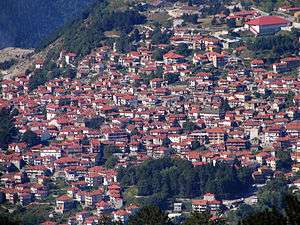


 Overview of Parga, on the Ionian coast
Overview of Parga, on the Ionian coast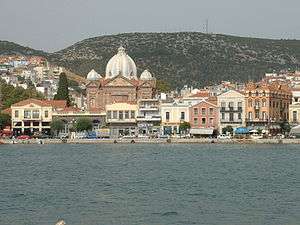
- Palace of the Grand Master of the Knights, in Rhodes island
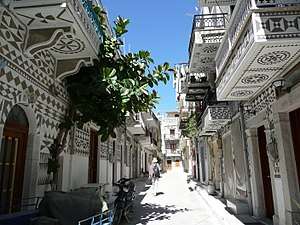 Mastichochoria, in Chios island
Mastichochoria, in Chios island- Volos seen from Mount Pelion
- View of the archeological site of Delphi

- Melissani Cave in Kefalonia island
 View of Kavala and its port
View of Kavala and its port St. George Monastery in Ioannina
St. George Monastery in Ioannina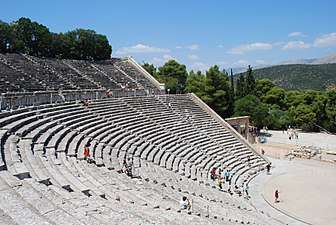 The ancient theatre at Epidaurus
The ancient theatre at Epidaurus- The Palace of Mystras, Peloponnese

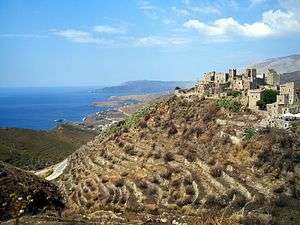
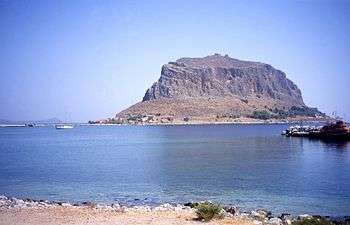 The Rock of Monemvasia
The Rock of Monemvasia
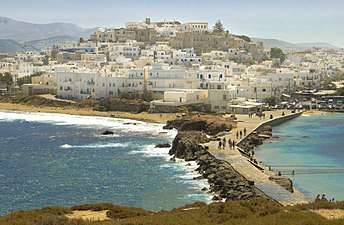 Naxos (city), on Naxos Island, Cyclades
Naxos (city), on Naxos Island, Cyclades
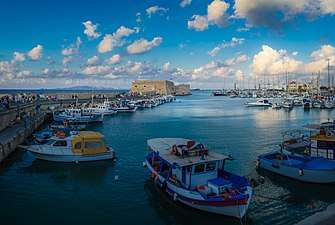
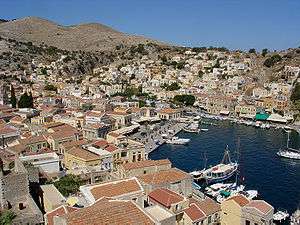 Symi island, South Aegean
Symi island, South Aegean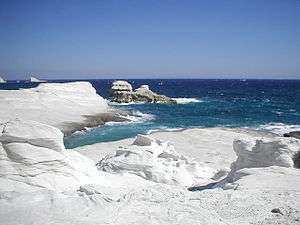 Sarakiniko Beach, in Milos island, Cyclades
Sarakiniko Beach, in Milos island, Cyclades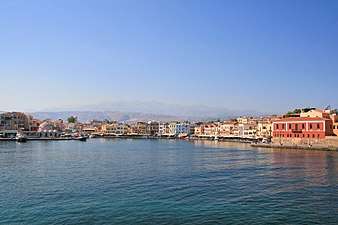 The Venetian port of the city of Chania, Crete
The Venetian port of the city of Chania, Crete
 The old Romaniote Etz Hayyim Synagogue in Chania, Crete
The old Romaniote Etz Hayyim Synagogue in Chania, Crete
See also
References
- ↑ "Greece Properties inscribed on the World Heritage List (17)". Unesco. Unesco.
- ↑ Greece by Paul Hellander, Kate Armstrong, Michael Clark, Des Hannigan
- ↑ "13 Places Where You Can See the Bluest Water in the World". Travel+Leisure. Retrieved 16 March 2017.
- ↑ "Greece Could See Record Year for Tourism". Retrieved 12 August 2018.
- ↑ "Towards 32.5 million record of tourists in Greece for 2018". ypodomes.com. Retrieved 7 April 2018.
- ↑ "Extra 2 million tourists to visit Greece". Avgi. Retrieved 7 April 2018.
- ↑ "Great record: 30 million tourists in 2016 (Μεγάλο ρεκόρ: Αγγιξαν τα 30 εκατ. οι τουρίστες το 2016)". imerisia.gr. Retrieved 30 April 2017.
- ↑ "Historic records for tourism (Ιστορικό ρεκόρ για τον τουρισμό)". topontiki.gr. Retrieved 6 March 2017.
- ↑ "For a Sustainable Tourism Industry". Retrieved 6 March 2017.
- ↑ "Greece Focuses on Religious Tourism, Explores Cooperation with Russia". gtp.gr. Retrieved 6 March 2017.
- ↑ "Climate in Greece: temperature, precipitation, when to go, what to pack". www.climatestotravel.com. Retrieved 2018-02-19.
- ↑ weatheronline.co.uk. "Climate of the World: Greece | weatheronline.co.uk". www.weatheronline.co.uk. Retrieved 2018-02-19.
- 1 2 "Greece Tourism: Information about tourism in Greece and the Greek Islands". www.greeka.com. Retrieved 17 May 2011.
- 1 2 3 "Nights spent in tourist accommodation establishments – regional – annual data". epp.eurostat.ec.europa.eu. 2010. Retrieved 19 May 2011.
- 1 2 3 "Tourism" (PDF). epp.eurostat.ec.europa.eu. 2010. Retrieved 19 May 2011.
- 1 2 3 "24.2 mln tourist arrivals in Greece in 2014". Proto thema. April 2015. Retrieved 17 July 2015.
- ↑ "People's Daily Online -- Minister says Greece, China to be best tourist partners". Retrieved 9 June 2015.
- ↑ http://www.voiceofgreece.gr/OmogeneiaMainNews_en.asp?ID=22066
- ↑ "GNTO Offices Abroad". www.visitgreece.gr. Retrieved 19 May 2011.
- ↑ Ioanna Zikakou (25 August 2015). "New Record for Greek Tourism: Around 26M Arrivals in 2015".
- ↑ "Προβλέψεις για νέο ρεκόρ στον τουρισμό το 2016".
- ↑ "Ιστορικό ρεκόρ για τον τουρισμό".
- ↑ "Tourism in Greece". Tourism in Greece. Greeka.com. Retrieved 28 March 2014.
- ↑ NON-RESIDENTS ARRRIVALS FROM ABROAD: January – December 2015, Retrieved 31 October 2016
- ↑ "Country Information". Retrieved 9 June 2015.
- ↑ "Luxury Resorts and Residences in Greece – Costa Navarino". Retrieved 9 June 2015.
- ↑ (PDF) http://www.grhotels.gr/GR/BussinessInfo/News/Lists/List/Attachments/408/ENG-GreekTourismHotels2013.pdf. Missing or empty
|title=(help) - ↑ "Ξενοδοχειακό Δυναμικό Ελλάδας 2016 - Σύνολο Χώρας" (PDF). www.grhotels.gr. 2016.
- ↑ User, Super. "Hellenic Association Of Municipalities With Thermal Springs". www.thermalsprings.gr. Retrieved 7 October 2017.
- ↑ User, Super. "Hellenic Association Of Municipalities With Thermal Springs". www.thermalsprings.gr. Retrieved 7 October 2017.
- ↑ TheKoProSkila (29 November 2012). "Sarlitza Palace Hotel, Thermi – Lesvos". Retrieved 7 October 2017 – via YouTube.
- ↑ Interview: Natali Dologlou, MIRC, Greece, 21 January 2016
- ↑ Winter vacations in Greece, on visitgreece.gr
- ↑ http://www.enet.gr/online/online_text/c=112,id=905204. Retrieved 2009-02-23
External links
| Wikivoyage has a travel guide for Greece. |
- Official Greece tourism site
- Greece travel and tourism at Curlie (based on DMOZ)

